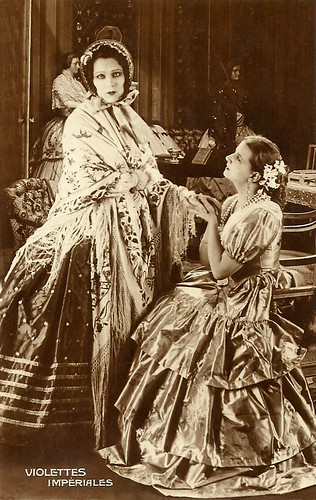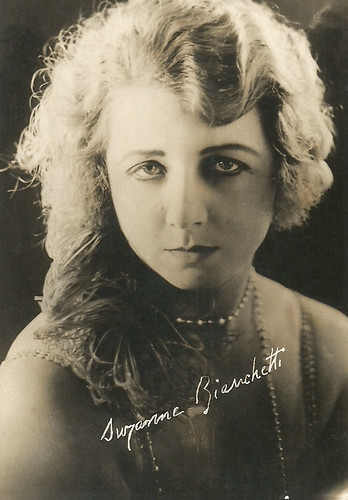
French postcard in the series 'Les Vedettes de Cinéma' by A.N., Paris, no. 174. Suzanne Bianchetti in Les Aventures de Robert Macaire/The Adventures of Robert Macaire (Jean Epstein, 1925).

French postcard in the series 'Les Vedettes de Cinéma' by A.N., Paris, no. 175. Photo: J. des Boutin.

French postcard by Cinémagazine-Edition, Paris, no. 747. Photo: Alban. Suzanne Bianchetti as Queen Marie-Antoinette of France in the Franco-German coproduction Cagliostro (Richard Oswald, 1929). The year written on the card does not refer to the French release, as that was in 1929 as well.
Short silent comedies
Suzanne Bianchetti was born in Paris in 1889. During the First World War, she made her cinema debut. Her first appearance was in the propaganda film La femme française pendant la guerre/The French Woman during the War (Alexandre Devarennes, 1917). She showed a definite talent for cinema.
At that time she married actor René Jeanne, who served as Director of the Etablissement Cinématographique des Armées. Later he became a journalist and scriptwriter.
She quickly became popular with short silent comedies like Riquette se marie/Riquette Marries (Alexandre Devarennes, 1918). Soon she became a star.
Her first dramatic part was in La Marseillaise (Henri Desfontaines, 1920) opposite André Nox. According to IMDb, she later “said in an interview that she thought of quitting film acting when she saw herself in that film”.

French postcard by Edition des Studios-Rahma, Paris. Photo: Suzanne Bianchetti as Marquise d'Harville in the film serial Les mystères de Paris/The Mysteries of Paris (Charles Burguet, 1922).

French postcard by Edition Cinémagazine. Photo: publicity still for Violettes impériales/Imperial Violets (Henry Roussel, 1924) with Raquel Meller as Violetta and Suzanne Bianchetti as Empress Eugénie. Visible in the back is the Chateau de Compiègne, Napoleon III's residence.

French postcard by Edition Cinémagazine. Photo: Raquel Meller as Violetta and Suzanne Bianchetti as Empress Eugénie in Violettes impériales/Imperial Violets (Henry Roussel, 1924).
Ideal as sovereigns
During the 1920s Suzanne Bianchetti became one of France's most loved and respected actresses and worked with many of the notables of the silent film era, such as Antonin Artaud and the singer Damia.
A director who particularly appreciated her was Jacques de Baroncelli, under whose direction she made Flipotte (Jacques de Baroncelli, 1920) and Le rêve/The Dreasm (Jacques de Baroncelli, 1921), both starring Gabriel Signoret , Le père Goriot (1921) with Jacques Grétillat, La légende de sœur Béatrix (Jacques de Baroncelli, 1923) with Eric Barclay and La flambée des rêves (Jacques de Baroncelli, 1924) with Charles Vanel.
Her other silent films include Jocelyn (Léon Poirier, 1922), the populartwelve-part serial Les Mystères de Paris/The Mysteries of Paris (Charles Burguet, 1922), adapted from the work of Eugène Sue, Violettes imperials/Imperial Violets (Henry Roussel, 1924) with Raquel Meller, and the American romantic costume comedy-drama Madame Sans-Gêne (Léonce Perret, 1925), a lavish Paramount production starring Gloria Swanson.
The talented Bianchetti was ideal for roles as sovereigns. In 1927, Bianchetti appeared in her two most famous films, as a haughty and contemptuous Marie Antoinette in the classic epic Napoléon (Abel Gance, 1927) and as Catherine II in Casanova (Alexandre Volkoff, 1927) featuring Ivan Mozzhukhinas the great seducer.
A year later she appeared in another silent classic, Verdun, visions d'histoire/Verdun (Léon Poirier, 1928) as the wife of the French soldier (Albert Préjean). She played Marie Antoinette again in Richard Oswald's Cagliostro (1929), filmed in Germany with Hans Stüwe in the role of the famous adventurous doctor, adept in occult sciences.

French postcard by A.N., Paris, no. 344. Photo: Alban. Suzanne Bianchetti in Verdun, visions d'histoire/Verdun (Léon Poirier, 1928).

French postcard by A.N., Paris, no. 549. Photo: Alban. Suzanne Bianchetti as La Femme (the wife) in Verdun, visions d'histoire/Verdun (Léon Poirier, 1928).
A martyr
After the introduction of sound film, Suzanne Bianchetti could be seen in re-edited versions with sound-effects of Verdun, visions d'histoire, retitled as Verdun, souvenirs d'histoire (1931), Violettes impériales (1932) and Napoléon as Napoléon Bonaparte (1935).
Among the films she made afterwards were Princes de la cravache/Princes of the whip (Marcel L. Wion, 1930), Le roi de Paris/The King of Paris (Léo Mittler, 1930), La folle nuit/The Mad Night (Robert Bibal, 1932) and Aux portes de Paris/At the gates of Paris (Charles Barrois, Jacques de Baroncelli, 1934).
Her final film was L'Appel du Silence/The Call of Silence (Leon Poirier, 1936), based on the life of Charles de Foucauld (Jean Yonnel). Foucauld was a French priest living among the Tuareg in the Sahara in Algeria. He was assassinated in 1916 outside the door of the fort he built for the protection of the Tuareg and is considered by the Catholic Church to be a martyr.
In 1936, Suzanne Bianchetti died in Paris at the age of 47. Bianchetti was married to writer and actor René Jeanne who served as the director of L'Etablissement Cinématographique des Armées.

French postcard.

French postcard, Spa - Rueil.
Prix Suzanne Bianchetti
A year after her death, Suzanne Bianchetti's husband created an award in her memory to be given annually to the most promising young actress. It was given for the first time in 1937 to Junie Astor for her performance in Club de Femmes.
The award comes in the form of a medallion engraved with Suzanne Bianchetti's image. Since its inception, the Prix Suzanne Bianchetti has been awarded to many of the greatest names in French cinema who went on to national and international success.
Among the winners are Micheline Presle, Simone Signoret, Marina Vlady, Annie Girardot, Pascale Petit, Isabelle Adjani, Isabelle Huppert, Juliette Binoche and Audrey Tatou.

French postcard by Cinémagazine-Edition, no. 35. Photo: Wyndham.

French postcard by Editions FILMA, Paris, no. 109. Photo: Wyndham.

French postcard by Editions Filma in the series Les vedettes de l'ecran, no. 109. Photo: Manuel Frères.
Sources: Marlène Pilaete (CinéArtistes - French), Wikipedia and IMDb.
This post was last updated on 17 May 2023.
No comments:
Post a Comment